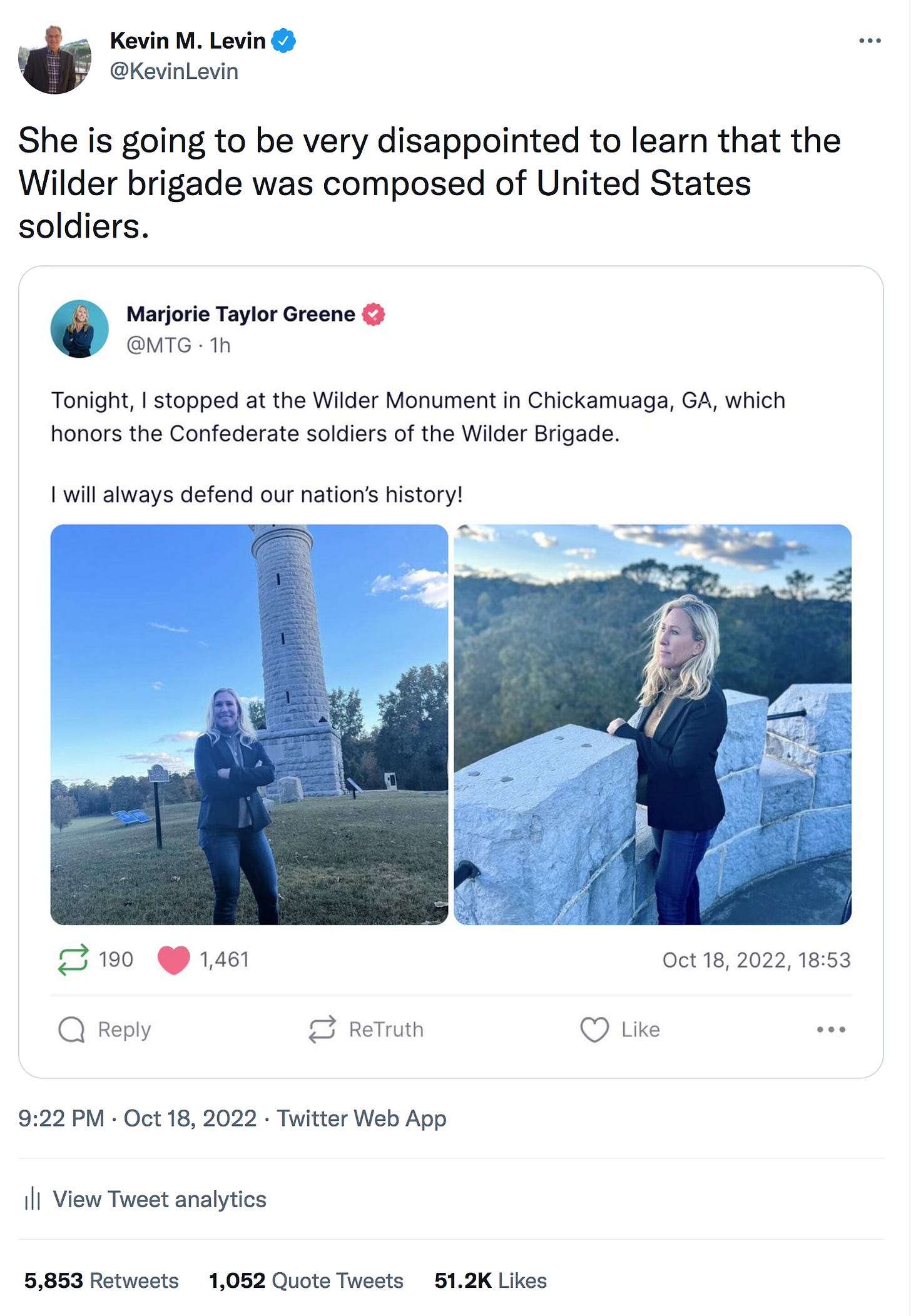Earlier this week Georgia Republican representative Marjorie Taylor Greene demonstrated her ignorance of Civil War history while walking the Chickamauga battlefield. After stopping at the Wilder monument she posted the following on Truth Social—the social media platform started by former president Donald Trump.
As I and plenty of other people have pointed out, the Wilder monument was composed of United States soldiers. The post was taken down and a new one published with the correct information.
Of course, it’s an open question as to whether the initial post was intentional or an oversight given that it only appeared on Truth Social and not on Twitter. Perhaps it was tailored specifically for a certain audience. Anything is possible given the Republican Party’s leverage of Confederate heritage in recent years, especially after Trump stood by white nationalists in Charlottesville and their defense of a monument to Robert E. Lee that the city planned to remove.
I don’t know what the congresswoman intended and ultimately it is irrelevant. What stands out to me is the predictable way in which both her defenders and detractors responded to the initial post. In both cases we are left with a one-dimensional view of the Civil War and a public memory that is much too weighed down by overly simplistic distinctions between North v. South, Confederate v. Union, and Lost Cause v. Emancipation.
John T. Wilder was born in New York and grew up in Indiana. Wilder rose to the rank of colonel before having to resign from the army in 1864 as a result of continuous bouts of dysentery after contracting typhoid fever in 1862. After the war, Wilder remained in the South, becoming mayor of Chattanooga, Tennessee. He also founded the town of Rockwood, TN.
Wilder was instrumental in helping to create what became the Chickamauga & Chattanooga National Military Park—the first national military park created by the federal government in 1890. The pull of national reunion was strong among the former Union and Confederate veterans who worked together to establish the park. [I highly recommend Bradley Keefer’s book, Conflicting Memories On The 'River Of Death': The Chickamauga Battlefield and the Spanish-American War, 1863-1933 for more on this history.]
History is complicated once you choose to dig in and put aside preconceived assumptions and unhelpful generalizations.
It is entirely possible that Representative Greene believed that she was looking at a Confederate monument. After all, the current debate about Civil War monuments and most of the news stories about their removal have been centered around Confederate monuments, located in towns and cities across the South. I suspect that there are plenty of people who have no idea that monuments to United States soldiers and the Union cause can also be found, albeit in much smaller numbers.
It’s easy to get caught up in a social media firestorms like this, but we also need to keep in mind that it matters little beyond the likes and retweets. It’s purely epiphenomenal.
If we are to take anything away from Greene’s visit to Chickamauga it is that the work we do as historians, public historians, and educators, day in and day out, matters a great deal.





Kevin, Your excellent take on the important work of historians and the need for our citizenry to know that history notwithstanding, MTG is STILL an idiot, and I say that based on direct observation.
A book recommendation for you, if you've not yet gotten to it: Teaching White Supremacy by Donald Yacovone (Harvard). An excellent work on how we have written about and taught history for the last 200 years.
It wouldn’t matter what the truth was to these people or the legions who support them. The facts are irrelevant to them, not just in this matter but everything else.